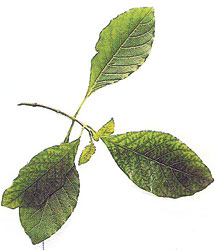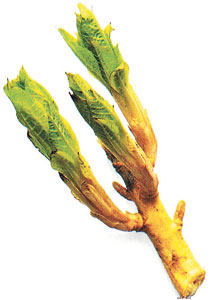'Dengue was first reported in Sri Lanka in 1965 but has become a regular epidemic since 1989. The peak incidence of the disease generally comes after the monsoon season, in June - July and October - December, when the density of the
two mosquito carrier species - Aedes aegypti and Aedes albopictu - is especially high'.
(National Plan of Action for Prevention and Control of Dengue Fever 2005 - 2009 Epidemiology Unit, Ministry of Health, Sri Lanka)
A virus carried by mosquitoes, mainly by the Aedes aegypti, causes Dengue fever. After an attack, the body is able to provide immunity for about nine months, which means that a person can contract Dengue repeatedly in their lifetime.
 |
| Cinchona |
The incubation period, between the bite and the onset of symptoms, is about five to six days. This is usually preceded by two days of headaches and malaise. A blood test to check for the Dengue antibody may provide evidence of the infection.
Characteristic symptoms
of Dengue
- Fever lasting more than three days. It tends to go down for a day or two, only to reappear.
- Rash of a scarlet colour, starting in the limbs and spreading to the body and face.
- Photophobia where the eyes become sensitive to light.
- Nausea and vomiting.
- Excruciating body pains and headache.
- Bleeding from the nose, mouth or rectum may indicate haemorrhagic dengue fever.
Treatment
The best treatment is prevention. Therefore make sure you have no water or garbage stagnating in and around your neighbourhood. Patients suffering with Dengue fever should be protected from further mosquito bites, as the infection can be passed on to more individuals this way. Eating a healthy diet of fresh fruit and vegetables and wholesome food to maintain optimum health is also important.
 |
| Belladonna |
Homoeopathic constitutional prescriptions can also enhance your health, making you less vulnerable to the virus. This is when remedies are prescribed on a totality of each patient's symptoms; family history; general health and the root cause of the disease. Further, there are homeopathic remedies that have an affinity to specific cells and organs, like Echinacea that has been invaluable in the prevention and treatment of Dengue, because it improves the immune function in the body.
- Patients with a dusky appearance of the skin, inflammation of joints, no thirst or appetite with extreme tiredness have responded well to Apis Mellifica (honeybee venom) and Belladonna atropa that helps with fever, headache and photophobia. The Belladonna plant is found in Greece, Italy and England.
- Patients complaining of violent muscle/joint pain and headache were prescribed Eupatorium perfoliatum made from the tincture of the whole plant.
- Cinchona officinalis or Peruvian bark – the remedy made from the tincture of the dried bark is used to stop vomiting and nausea. It also helps the liver and kidneys effectively excrete toxins, caused by the viral infection . Plenty of fluids help to flush these poisons out of the body and maintain blood volume. This remedy also promotes the production of platelets and red blood cells. Normal numbers of platelets (between 150,000 and 300,000) are essential for the blood clotting process and normal amounts of red blood cells (four million) are essential because they carry oxygen to every cell.
- Echinacea angustifolia or the purple cone flower is well known for its immune enhancing properties. The remedy is made from the tincture of the whole fresh plant. This maintains the white blood cell count. White blood cells fight infection - viral or bacterial - and the optimum number present in the body should be between 7,000 and 9,000.
- In the case of Haemorrhagic Dengue, a homoeopathic physician can make use of remedies like Ipecacuanha or Ipecac root. This is made from the dried root of this plant and can stop the bleeding. Patients will be referred to a hospital if they require blood transfusion or intravenous fluids.
Homeopathic remedies have been used successfully in the prevention and treatment of Chikungunya as well. To prevent epidemic diseases like Dengue and Chikungunya, Echinacea can be prescribed daily during the peak seasons. Constitutional remedies may be given at the start of the peak season and repeated once every four weeks during the peak season.
Homeopathic treatment is cost effective and it can cut down the time of recovery as well as ensure a full recovery.
This article has been written for the purpose of informing the public. Patients should seek the advice of a homeopathic doctor for treatment.
The writer is a member of the Homoeopathic Association of Ceylon |


